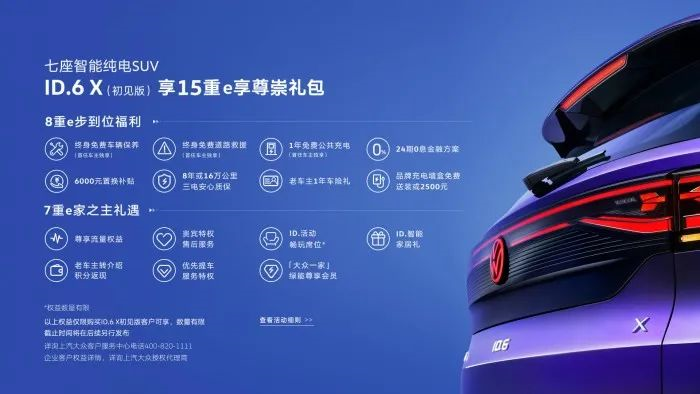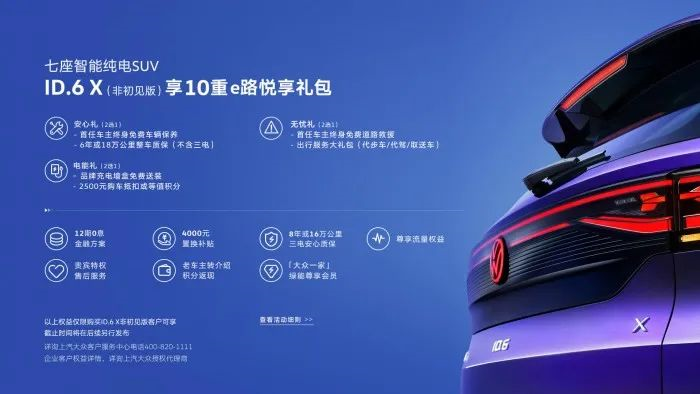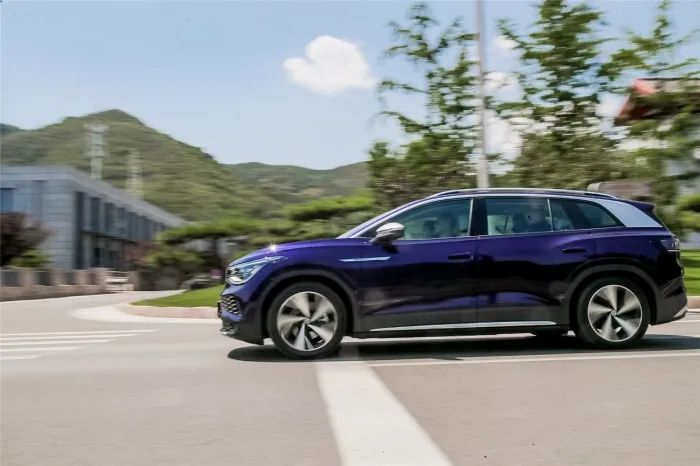On June 23, I test drove the SAIC Volkswagen ID.6 X in Beijing. On the same afternoon, Volkswagen Group announced that the Audi brand will stop selling fuel vehicles in 2033, but the last line of the announcement was heart-wrenching: “Does not include the Chinese market”. Why? One reason could be that Volkswagen’s electric vehicle products in the Chinese market have performed poorly. Just look at the sales figures for the Volkswagen ID.4, which barely exceeded a thousand units for both North and South Volkswagen in a month, and it tells the story of Volkswagen’s woes in China.
We always say there is still plenty of time for the “elephant to turn around”. At least that was the case last year when the proportion of Chinese new energy vehicle sales was around 5%, while Volkswagen’s fuel vehicle sales remained the highest. However, in the first quarter of this year, the proportion of Chinese new energy vehicle sales has already surpassed 10%. Although this growth rate will not be exponential in the coming years, we cannot underestimate its momentum. In the first quarter, Volkswagen only contributed a few thousand units to the hundreds of thousands of new energy vehicles sold.
When I test drove the SAIC Volkswagen ID.6 X, I should have talked to everyone about the product, but before that, I still believe that Volkswagen’s product strategy is more important than the product itself. This is closely related to whether Volkswagen can break the ice in the Chinese market.
Why is the second car ID.6 instead of ID.3?
In fact, the Volkswagen ID.3 has been on the European market for nine months. Judging from the time sequence, the ID.3 should have entered the Chinese market before ID.6. However, ID.6 has already entered the domestic market, while ID.3 will not enter China until the end of this year. The main reasons for this phenomenon are twofold. The first reason is from within Volkswagen. Currently, the ID vehicle models are being developed jointly by SAIC and FAW, and there are communication issues between North and South Volkswagen regarding the ID.3 model. Volkswagen in the north may be absent when ID.3 enters China. The second reason is the positioning and timing of ID.6 entering the Chinese market.
After one day of experiencing the SAIC Volkswagen ID.6 X, its feeling can be summed up briefly: significant space advantages and average intelligent experiences.The electric vehicle market in China has gradually formed a hierarchy based on intelligent technology. The brands at the top of the hierarchy are NIO, Li Auto, XPeng, and Tesla, whose fast iteration of intelligent software and hardware is one reason why some high-end electric vehicle consumers are willing to pay a premium for their products. Sales of these four brands are mainly concentrated in the “active market” for smart electric vehicles, which can be defined as regions with lower impact from license-plate regulations and where consumers have a higher enthusiasm for purchasing smart electric vehicles, such as Shanghai.
According to statistics, NIO’s sales in Shanghai account for approximately one-sixth of its total sales, and Tesla’s sales in Shanghai lead the nation. In the “active market”, consumers have stronger subjective awareness when choosing products, and they are not restricted by traditional demands such as space, cost-effectiveness, and practicality. The smart experience is given a high priority. However, the harsh reality is that the “active market” is not suitable for the SAIC Volkswagen ID.6 X, so the “passive market” is key to its breakthrough.
It is unknown whether SAIC Volkswagen did it intentionally or coincidentally, but the launch of the SAIC Volkswagen ID.6 X happened to be in the first month after the new energy vehicle quota policy reform in Beijing. According to traffic information broadcasting in Beijing, as of 24:00 on March 8, there were 153,944 valid codes for family new energy small passenger car quotas in Beijing. Based on their scores, 32,520 households can get their quotas on May 26, with a probability of about 21.12%. Among the households that received a quota, the highest score was 240 points, and most households with high scores had three generations participating in the lottery, such as the household with 240 points, whose earliest registered member participated in the lottery in January 2011. For households whose scores met the “passing grade” of 50 points, which totaled 494 households, the latest registered member participated in the lottery in September 2012.
Therefore, Beijing is currently the most typical “passive market” in the Chinese market. It is hard to imagine the desperation of those who have failed to win the lottery for fuel quotas for 10 years, while the new policy has opened the door for them to enter the new energy market. Of course, they can also participate in the household fuel quota lottery, but the probability of winning is so low that users have no choice.
Two key pieces of information we can obtain from the data are the sales window and the family as a core. Although the retention period for Beijing’s new energy quotas is one year, they are only distributed to users on May 26 each year. Therefore, the next two months will be a sales growth window for new energy vehicle models in the Beijing area.## Family positioning in Beijing’s new energy vehicle market
The family positioning in the current Beijing new energy vehicle market is more subtle. The first car model that comes to mind with family as the core selling point is the IDEAL ONE, but in Beijing, the IDEAL ONE must be purchased with fuel indicators. However, the problem that the 32,500 new energy indicator users face is that they have exhausted all their efforts to obtain a new energy license plate, so the selection of vehicles must be based on solving the needs of family travel, and traditional car purchase needs will also become a focus for these users. Therefore, the next two months will be a crucial time for SAIC Volkswagen to break the ice in electric vehicle sales. Beijing’s family registration policy is equivalent to screening potential users for the ID.6 X, and seizing this opportunity will bring a larger user base and higher market awareness to SAIC Volkswagen’s electric vehicle products.
Return “practicality” to the ID.6 X electric vehicle
The ID.6 X is a representative product of practicality. In terms of positioning and price, the ID.6 X achieves “consumption stagnation, product power upgrade”, with a price range of 239,888 yuan to 335,888 yuan and a body length, width, and height of 4876 mm1848 mm1680 mm and a wheelbase of 2965 mm. The length of ID.6 X is almost similar to that of the Volkswagen Touareg, and the inherent advantages brought by the MEB platform make the wheelbase of ID.6 X close to the Tiguan. Therefore, the ID.6 X is fully capable of serving as a family car. In order to meet users’ pursuit of cost-effectiveness, SAIC Volkswagen has also prepared multiple preferential policies for users, details of which can be seen in the figure below.


The car model we test drove this time is the ultimate long-endurance version, priced at 278,888 yuan, which I think will be the main sales force for ID.6 X in the market in the future. Focusing on family positioning, the two points that this ID.6 X is most concerned about by consumers are endurance and space. In terms of endurance capability, the official endurance score given by the ultimate long-endurance version is 588 kilometers, equipped with an 83.4 KW/h battery, and it takes 40 minutes to charge the battery from 0% to 80%. This series of data is at the upper-middle level in the market, and the quality of the car is already 2.28 tons, which is 200 kg heavier than the Tiguan.
 Based on our actual driving experience, the energy consumption data displayed on the on-board computer for every 100 kilometers travelled is 16.1 KW/h. By factoring in that there were four adult males inside the car during the calculation, the ID.6 X’s range can still exceed 500 kilometers. Therefore, the ID.6 X’s performance in terms of range is satisfactory for its users.
Based on our actual driving experience, the energy consumption data displayed on the on-board computer for every 100 kilometers travelled is 16.1 KW/h. By factoring in that there were four adult males inside the car during the calculation, the ID.6 X’s range can still exceed 500 kilometers. Therefore, the ID.6 X’s performance in terms of range is satisfactory for its users.
As for space, the seven-seater ID.6 X’s second row seats do not have an aisle in the middle, which makes it slightly inconvenient for passengers in the third row to get in and out of the car. However, the relatively large adjustable range of the second row seats provides enough space for the passengers in the third row. When I sat in the third row and adjusted the second row seats to a position where my leg space was sufficient, there was still enough legroom for the passengers in the second row. The ability to fully utilize the 7-seat space is a key factor in winning favor from users for family cars, and the ID.6 X has this capability, but the comfort of the third-row space is still not suitable for long-term sitting.
In addition to the above points, there are many other detail configurations crafted around a family-oriented concept in the SAIC Volkswagen ID.6 X. The car has a total of four USB-C charging ports and one wireless charging pad spread throughout the car. Higher-end models have heated second row seats with adjustable angles. The ID.6 X also has an extra-large full panoramic roof which can be opened in high-end models. Different from the panoramic roofs of many new generation cars, the ID.6 X’s roof is equipped with electric sunshades to save cost and avoid the problem of being ineffective in protecting against harmful UV rays, which many users have criticized with adjustable glass-roof. Thus, the ID.6 X is actually a product that takes practicality to the extreme, and this characteristics better meets the needs of traditional users.In terms of intelligence, the ID.6 X continues the design of the ID.4 X in many aspects. The car is equipped with a 5-inch instrument screen and a 12-inch central control screen, and it is equipped with Volkswagen’s intelligent car networking 4.0 system, with wireless CarPlay function. The UI design of the instrument panel is very clear, with ADAS module on the left, driving data in the middle, and navigation information on the right. SAIC Volkswagen has already connected the car and mobile phone network, especially for electric vehicles. Vehicle owners can get more vehicle information through mobile APP and remotely start the vehicle when needed.
The new ID.6 X also features AR-HUD, but the experience of this configuration is general. AR-HUD will project the arrow of navigation information above the normal HUD information. The so-called AR refers to the fact that the arrow of navigation will gradually become larger as the distance of the vehicle to the turning corner becomes closer, until the turning is completed and enters the next instruction. This function requires an additional 5000 yuan, but I think it is totally unnecessary.
In terms of driving assistance, the ID.6 X is equipped with IQ smart driving assistance system, which includes basic L2 level driving assistance functions such as ACC and lane keeping. The biggest highlight is the turn signal lane change function. Unfortunately, due to the nature of being an engineering vehicle, we did not experience the driving assistance system.
We can also see that Volkswagen is trying to keep up with the pace of the intelligent car era on the ID.6 X. Gravity sensing start-up of the seat, rotary knob for shifting gears, high-energy recovery gear and other designs make driving more convenient. Of course, the purpose of simplifying all driving actions is to welcome the arrival of the era of autonomous driving.
Traditionally, distribution networks are the guarantee to boost sales. Potential users of SAIC Volkswagen ID.6 X can now place orders online through a mobile APP, and they can choose to have the vehicle delivered to the nearest SAIC Volkswagen 4S store. New force car companies pursue direct sales, but setting up sales network is a very time-consuming process. Compared with this, traditional car companies have many resource advantages in the market. Their huge sales network is one of them. They can quickly launch their products in China’s first, second and third-tier cities without having to set up network levels one by one.
In conclusion, SAIC Volkswagen’s ID.6 X is a good effort to keep up with the pace of the intelligent car era, with a clear instrument panel and driving assistance functions. The traditional sales network is still the guarantee to boost sales.Although the ID.6 X may be a conservative product compared to new forces in the automotive industry, I believe that continuing to rely on traditional combustion engines is a short-sighted solution. When large-scale transformation comes, consumers will certainly reassess traditional car companies’ electric vehicle products. This has become evident with the ID.4 X, as SAIC Volkswagen’s decades of history and customer reputation have failed to endorse their electric products, losing out to the “little guy” Tesla. Therefore, SAIC Volkswagen’s urgent deployment of pure electric products is the right choice. In this era of electrification, it is not only about technology and product competitiveness, but also about racing against time.
This article is a translation by ChatGPT of a Chinese report from 42HOW. If you have any questions about it, please email bd@42how.com.
